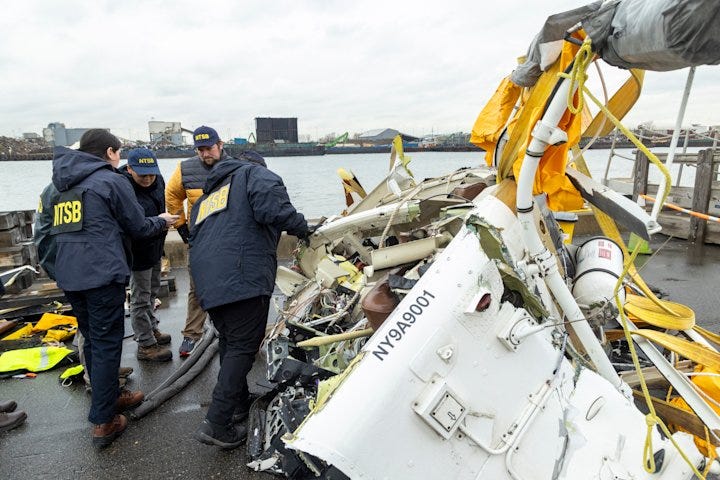Helicopter 'suddenly' broke apart before plunging into Hudson River, NTSB says

A sightseeing helicopter that crashed in New York City’s Hudson River in April, killing all six people on board, "suddenly" broke apart before plummeting into the water, the National Transportation Safety Board said in a preliminary report.
The single-engine Bell 206 helicopter, operated by New York Helicopter Tours, departed on April 10 at about 2:58 p.m. from a downtown Manhattan helicopter pad and later flew north over the Hudson River before crashing about 17 minutes later, according to the NTSB report released on May 7. A family of five from Spain, along with a pilot, were all killed in the incident, authorities said.
Surveillance footage and audio captured the helicopter traveling south before it "suddenly separated into three major sections," the NTSB said in the report. The sections were recovered in the wreckage and identified: the fuselage with the engine; the main rotor system with both rotor blades, transmission, and roof-beam structure; and the tail boom with the tail rotor.
"Several witnesses described hearing several loud 'bangs' emanating from the helicopter before it broke up and descended into the river," according to the report.
Debris from the helicopter was discovered submerged in several areas in the river and on the surface of the river, the NTSB said in the report. Debris was also recovered from a rooftop near the Hoboken Terminal, a major transportation hub in New Jersey.
The crash drew worldwide headlines and renewed scrutiny over the controversial helicopter tourism industry in New York. The incident remains under investigation by the NTSB and Federal Aviation Administration.
The NTSB's preliminary report did not conclude what may have caused the crash. It typically takes about a year or more before the NTSB determines a probable cause and a final report is released.
NTSB preliminary report offers timeline of the helicopter's flight

The family from Spain, which included an executive at tech company Siemens, his wife, and three children, was on an aerial sightseeing tour with New York Helicopter Tours, authorities said.
During the flight, the helicopter "flew a teardrop pattern" south of the Statue of Liberty and traveled north along the east side of the Hudson River, according to the report. The aircraft then flew past the George Washington Bridge before it made a U-turn and went south along the New Jersey side of the river.
As the helicopter approached the Holland Tunnel's ventilation towers near Jersey City, New Jersey, it was flying at an altitude between 625 to 650 feet, the NTSB said in the report. The Holland Tunnel is a vehicular tunnel under the Hudson River that connects Lower Manhattan in New York City to Jersey City.
The helicopter's altitude then increased 675 feet before it rapidly descended and hit the water, according to the report.
Crews and investigators spent days recovering the wreckage. The NTSB said in the report that the helicopter was not equipped with video or data recording devices.
"Photos of the pilot taken just before the helicopter departed indicated that he was wearing computer-augmented sunglasses, which had video and audio recording capability," according to the report. "The sunglasses were not recovered."
The helicopter airframe had accrued 12,975 total hours of operation, and the engine had accrued a total of 23,305 hours of operation, the NTSB said in the report. The helicopter's most recent inspection was conducted in late February, and it had operated about 50 hours since then.
The pilot worked a 10-day on, 10-day off schedule, and the crash occurred during his first day back at work, according to the report. The flight was his eighth tour excursion of the day on the same helicopter.
Make your journey safer and smarter: Sign up for Paste BN's Travel newsletter.
Fatal helicopter crash sparks safety concerns
The incident renewed safety concerns over the commercial helicopter industry, and aviation experts have long called for stricter regulations to improve the safety of these flights. Helicopter tours in New York have been controversial, and some flights have turned deadly, Paste BN reported.
The United States operates the world’s largest fleet of commercial helicopters and is home to the biggest market for helicopter tourism in destinations like New York City, Hawaii, and the Grand Canyon. According to the FAA, helicopters have a fatal accident rate of 0.63 per 100,000 flight hours for helicopters, which is lower than the general aviation average but higher than commercial airline rates.
Following the crash, Senate Minority Leader Chuck Schumer urged the FAA to revoke New York Helicopter Tours' operating certificate immediately. Schumer also called on the FAA to increase regulations for helicopter tours, including expanding ramp inspections — surprise safety inspections — at helicopter tour companies across New York City.
On April 14, the FAA issued an emergency order grounding the helicopter tour company. The order came a day after the agency had announced that the company was shutting down its operations.
Contributing: Kathleen Wong and Zach Wichter, Paste BN; Reuters
(This story was updated to correct a typo.)